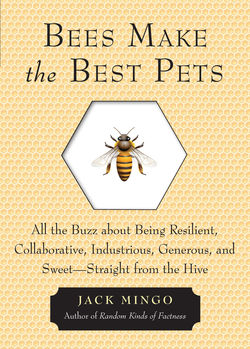Читать книгу Bees Make the Best Pets - Jack Mingo - Страница 12
На сайте Литреса книга снята с продажи.
There Are Always Exceptions
ОглавлениеRemember that I said worker bees don't “normally” lay eggs? That's because the queen's pheromones suppress the reproductive systems of the workers. However, if the queen dies and there are no larvae that can be groomed to replace her, that can change. Unless a beekeeper intervenes with a new queen, the hive is doomed. In that case, a terminally queenless colony will try to spread its genes before it dwindles away, using an unexpected tactic: some of the workers will start laying eggs. However, since they haven't mated, their unfertilized eggs will yield only drones (as mentioned above). Maybe some of them will get lucky and find a willing queen, passing the hive's genes along in its dying days.
When older bees begin collecting nectar and pollen from outside the hive, their brains change, and not really for the better. For example, after they memorize the surroundings of the hive, they lose the ability to learn new things. Normally, they stay that way until they die. However, sometimes “normal” gets disrupted; for example, if a hive has to grow a new queen, there can be a month-long gap before any new bees hatch. Normally, that would mean the larvae from the new queen wouldn't have young nursery workers available to take care of them, and they'd die. In that case, some of the field bees return to the nursery worker job. Here's where it gets interesting: researchers from Arizona State University discovered that going back to larvae-rearing makes their old brains work again like young brains, restoring their mental agility and ability to learn. (Interestingly, many human grandparents have discovered that keeping up with their fleet-footed, quick-witted grandkids has a similar effect.)
THE ROYAL SENDOFF
When a new queen is ready to fly off and mate, there's an interesting pageantry in the beehive that looks reminiscent of royal weddings. Suddenly thousands of worker bees pour out of the hive at once. Those that can fly take to the air, flying excitedly in circles above the hive; the young flightless bees congregate on and around the landing board like well-wishers. They are not aggressive, and you could almost interpret their behavior as celebratory (and who knows, it might be). However, this grouping and flying has survived as a behavior because it serves a purpose. It's dangerous to leave the hive, especially for a big, juicy, slow-moving queen, because many birds love eating bees. By coming out in large numbers, there's a variety of tasty looking targets, so the queen has a much better chance of surviving, even if a hundred bees get eaten during that time. If the queen is only one of 10,000 or more crawling and flying around, the odds are only one in a hundred that she'll be one of the unlucky ones.
The King Is Dead, Long Live the Queen
“If there's a queen bee, is there a king bee?” People have had strange ideas about bees for eons. In the first century AD, the poet Virgil wrote a guide to beekeeping in which he stated that bees reproduced asexually. This idea that honey and beeswax came from a sexually chaste source, mirroring their belief about the mother of Jesus, was particularly appealing to the Catholic Church. As a result, beehives were commonly kept around missions and convents, and only beeswax candles were considered unadulterated enough to burn on church altars.
Beehives back then were kept in skeps, one-piece woven baskets covered with hardened mud or dung, which didn't allow much investigation into the inner workings of hive life. At some point somebody noticed that there was a bigger bee of some kind in there. The assumption, based on the society of the time, was that it must be the king that ruled over the hive and told the workers what to do. It wasn't until the 1500s that it was suggested that the king bee was not only female, but also the one that laid all the eggs. Still, the assumption didn't change that she was a virgin queen, ruling over the hive population of male workers. Consider the surprise of male scientists in the 1670s, messing around with a new invention called a microscope, when one of them discovered that all of the workers were females.
Still, thanks to the “queen” label, most people assume that the queen bee is the leader of the hive. Not true. The hive is essentially a well functioning anarchist community, with bees doing what needs to be done based on their biology and instincts. Decisions are not made by dictate or consensus; they're hardwired into the bees. When something needs to be done, one or more of them does it. The queen is an important member of the hive with a singular job to do, as well as the mother of all the workers, but she is as much the prisoner of the hive as its queen. And her mates, the drones, aren't even princes—they're more like disposable consorts. Very disposable, it turns out.
. . . beehives were
commonly kept
around missions and
convents, and only
beeswax candles were
considered unadulterated
enough to burn
on church altars.
